Going 1:1: Top 5 Insights from ASB Unplugged by Kim Cofino
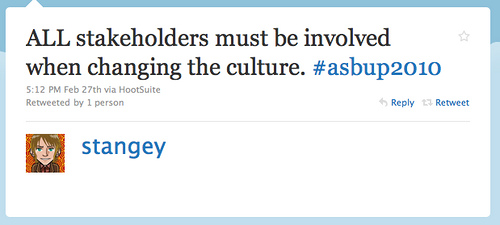
Cross-posted on Always Learning
Last week I was extremely fortunate to attend the ASB Unplugged Conference in Mumbai, India at the American School of Bombay, with my lovely colleagues, Chrissy Hellyer, Heather Vlach, Dana Watts and Jean Williams. Not only was Mumbai absolutely amazing in every way, but the conference was a treasure-trove of ideas, inspiration and advice for teachers and administrators in 1:1 schools (or those planning to go 1:1). Here are the top 5 things that really jumped out at me during the conference:
1. Involve all stakeholders
Every single presenter in every single session I attended, from Bruce Dixon to Scott McLeod, to Alex Inman, highlighted the absolutely critical importance of involving all community members in the planning and decision-making processes involved in going 1:1. In addition, it was crystal clear that ASB had done just that, with engaging sessions offered by both parents and students, and with almost every staff member I met being not only a teacher or administrator, but also a member of the Technology Committee.

As Alex pointed out during his session, "When people feel like they're part of a process, if they feel heard and like they're generally listened to, that's how you get buy-in." He laid out a clear (and well-tested) process for bringing in all voices as schools make the transition: Step 1: Determine your goal: Not just to have a 1:1 program - what exactly are you hoping to see? Step 2: Create focus groups of major constituents:
- Provide a safe space (don't put teachers and supervising admin in the same group)
- Aim to ask the groups only 4 essential questions, so there's enough time to discuss them (have outside consultants asking the questions)
- Take the discussion from the focus group and create a "language" for the goals, and rewrite the goals taking into account what you've learned, called consensus goals
Step 3: Build survey based on responses
- Include positive and negative concerns. Including concerns in the survey gives voice to the grouchy people, and then gathers some buy-in from them, and you find out if you've a) dismissed that person too quickly, or b) it really is only that one or two people who have negative concerns.
- Think long-term, but be certain to deal with the short term as well.
- Do this with the purpose of creating an assessment too, shows that you've listened - not just asked for feedback and done nothing with it. It's very important to use the language the focus group has used - otherwise it's hard for the focus group to tell that their concerns were heard.
Designing the Survey: (put the following items in the survey)
- Demographics: Need to be able to sort the survey, make sure to ask the right questions (from the focus group, look at where you saw differences in the responses, and make sure you add that option to your survey)
- Value & appreciation of 21st century skills - attitudes and values that you care about need to stem from the mission statement
- Personal Technology Literacy
- Professional Practices: practical applications of pedagogy and technology
- Perceived benefits and concerns of going 1:1
- Professional learning networks (who or what is their PLN)?
- If your questions are framed within the values and mission of your school, then when you get them talking about 1:1 they're already thinking about the values and mission of your school
Step 4: Analyzing the results:
Tools and ideas to transform education. Sign up below.
- Keep an open mind - if you don't regularly seek feedback from people, the first time they take a survey (esp if it's anonymous), they will dump on you - it's cathartic, they've been waiting (do the survey before the deployment, then half way through, then the end of the year. after the first year, just do it once a year)
- Review by committee - don't look at your data in a vacuum & publish that data
- Strongly consider getting objective third party help
The 21 Steps to 21st Century Learning from the Anytime Anywhere Learning Foundation also outlines a very clear process for involving all stakeholders and successfully implementing a 1:1 program from planning, to preparation, to implementation, to review.

2. School leadership must take an active role in the process of implementing 1:1
Both Bruce Dixon's pre-conference and Scott McLeod's Leadership Institute highlighted the importance of any 1:1 initiative (well, any school initiative, really) being actively led by school administrators. Bringing in a 1:1 program is not something that impacts just one grade level or one group of students and teachers. Regardless of how it starts in a school, it is something that will change school culture, school community, and school operations.
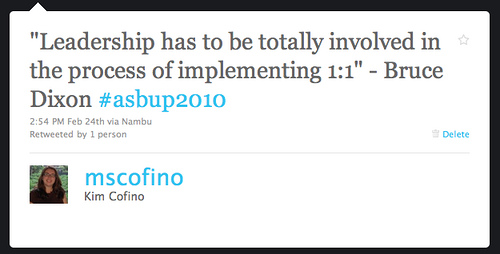
The school must have an administrator who not only champions the concept, but who also can promote it within the school community, who understands the change it will bring, and who will wholeheartedly support the teachers, students and parents who will undoubtedly be affected by this new learning environment.
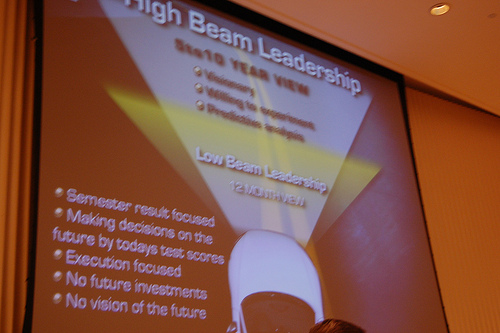
Scott Klososky and Paul Fochtman (the Superintendent of ASB) presented a joint session on the concept of High Beam Leadership - using data to analyze and predict the future so that you're making decisions with a 10-year view. They highlighted high beam leadership as critical, especially in the area of technology, and that for school leaders to get an accurate perspective on the future, they need to be in control of the "river of information" streaming into their lives. School leaders must be actively aware of the changes technology is bringing to society to be able to successfully plan with a long term vision for their school. Understanding and utilizing the power of tools like RSS, Twitter, and blogging to stay up-to-date is now a requirement.
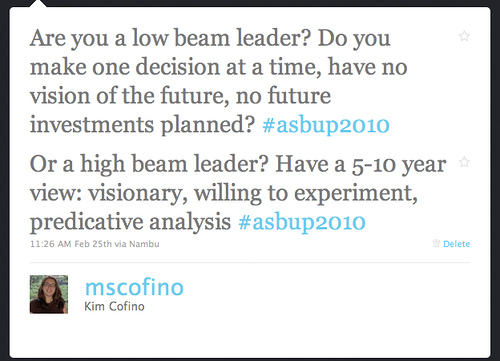
According to Scott and Paul, school leadership should also be willing to take some chances. Schools have a tendency to "wait and see" what happens when other schools implement new initiatives, for example 1:1. Unfortunately the "wait and see" method means that you're relying on the herd and essentially letting others make decisions for you. A critical skill highlighted with the High Beam concept is the ability to take control of all the information that's available and to make your own decisions. If you're just following what others are doing, you're not really planning for the future.
3. Our schools are great at buying "things."
During Scott McLeod's session, in a room full of international school administrators (and their tech teams), we took a quick survey based on the ISTE Standards for Administrators. Sadly, the results of the survey were pretty obvious:
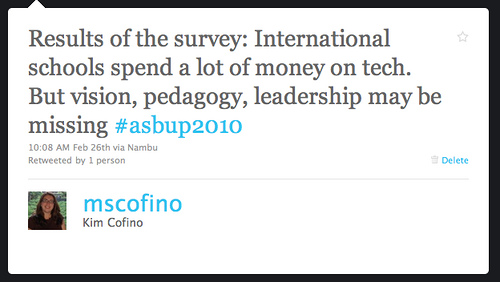
Clearly, it's easy for our well-funded schools to buy hardware, but it's not so easy to develop and articulate a clear vision for what to do with those tools, or to implement long-term, effective professional development in order to make the most of the things we bought, and many of our school leaders prefer a more "hands off - let the tech team take care of tech" approach, rather than a true understanding of what this hardware should be creating in our schools. Scott talked a lot about the changes our economy has gone through in recent years and what that will mean for the future (and our students). "Every single information-oriented segment of society is being dramatically impacted by the information revolution in society. Including schools." Scott emphasized the need to understand that this impact is going to continue to grow and that more and more industries will be replaced either by technology tools directly, or what technology can enable us to do (for example: travel agents are no longer needed because people can book flights and hotels online). For a more detailed explanation, I highly recommend Scott's 2008 K12Online presentation about the book Disrupting Class by Clayton Christensen. Scott also talked about the importance of scaleability - being able to take an initiative from one grade level (say a 1:1 pilot) and being able to scale it to all grade levels at the school:
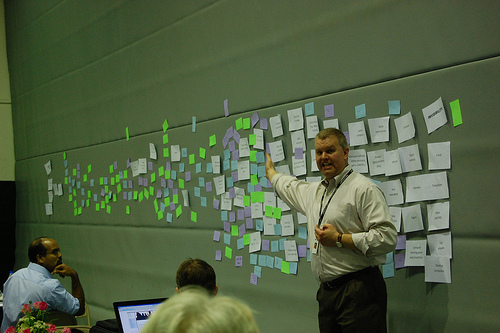
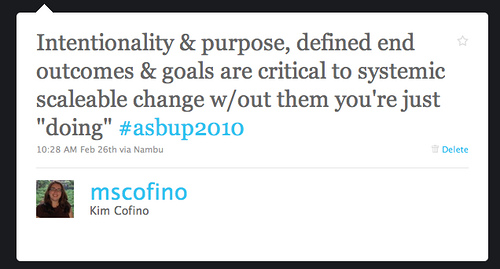
4. Project Based Learning is where it's at!
One of the highlights of the conference for me was visiting the Flat Classroom Workshop strand, which ran parallel to the formal conference. Watching students and teachers collaborate on an authentic challenge, collaborating to solve a problem, sharing creative solutions and being able to explain their ideas to outside observers is what I wish I was seeing and doing in school every day. It is the dream educational experience. I've already raved about it from the 21st Century Learning Conference in September, but it was great to see it in action again.
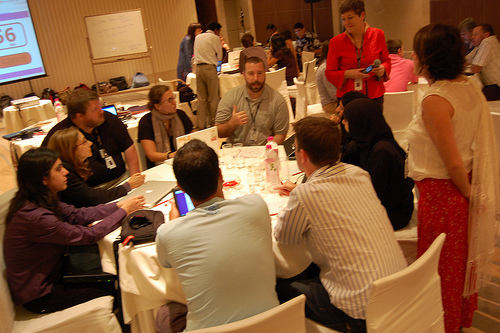
Andrew Churches'sProject Based Learning Institute also highlighted the power of designing authentic projects. Although he used a model created by Ted McCain (the 4Ds), I was so pleased to see many obvious parallels to the MYP Technology Design Cycle:
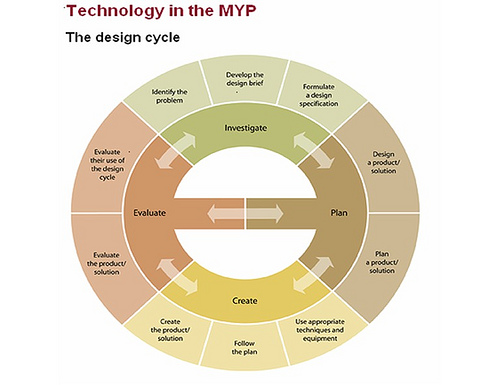
Allowing students to collaborate and create and lead themselves in their own learning is where we need to be heading, but it seems to need a specific infrastructure or expectation in schools. I see it happening regularly in MYP schools, so perhaps that is an essential element to successfully implementing this kind of learning experiences on a school-wide level. As Scott McLeod said during his session, "what we remember best/most is what we attach meaning to. It's very hard to attach meaning to decontextualized facts." Project Based Learning ensures that learning is contextualized from start to finish.
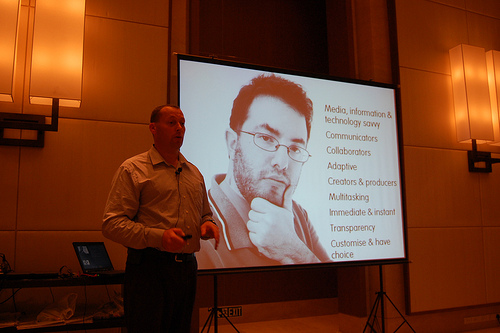
5. It's the little things that make a difference
From the student- and parent-led sessions, I saw so many great tips and ideas for successfully implementing a 1:1 program with the whole school community: From the students:
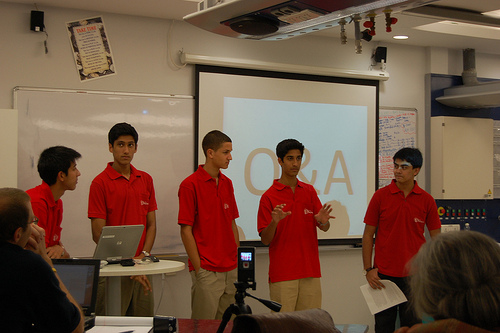
- 1:1 is an advantage b/c: "Teachers don't need to be a source of raw information anymore & they can finally actually teach"
- "Computers automate the tedious processes & give us time to focus on the more creative and processes"
- Students are not ready to go paperless, yet. They like the tactile experience and no boot-up time of working with paper and pencil when relevant.
- Students say: how we engage with info has changed very little in our 1:1 prog. The change = fewer unnecessary mundane steps.
- "Becoming a laptop school streamlines communication between all members of the community"
- School supports the use of an ASB Student Council Facebook fan page as an easy way to communicate exciting news and events with students at school.
- "It's always possible to get distracted - the tech office can try to block things for a little while, but we always find a way. In the real world, there are always distractions, having a laptop teaches you how to be productive in that environment"
- "Putting things on youtube makes it more fun. Videos you do for Spanish projects can become a viral video in the school"
- "At the end of the day, it makes more sense to have 1 place for all online class communication"
- Advice from students: Ask students what they like when exploring with new tech tools, don't force tech where it doesn't fit - choose the right tool for the task.
- "Anytime we get the blue screen of death, we're allowed to get up and run to the IT office."
From the parents:
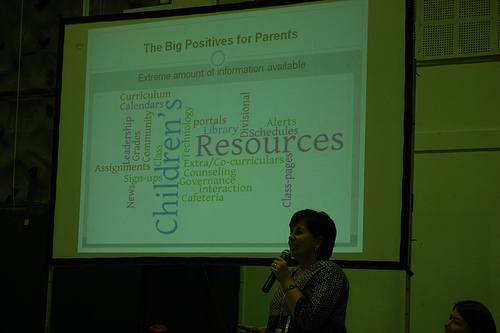
- It's absolutely critical to get all stakeholders engaged.
Evolution of the program:
- The school portal is important to keep lines of communication open, included is: the online gradebook, a parent Ning, the eLibrary.
- School management systems is not about control, it's about building a new relationship with your child.
- Training programs for parents create less resistance to change
- Open door policy for tech support - the key element of success
- Each year, more parents become actively engaged
Challenges:
- Learning curve: parents need to be ready to go from day one with distance learning, sign-ups, communication w/teachers, navigating the portal. The tech team now offers a tech orientation for parents to show the portal and the Ning before the first day of school.
- When some families first arrive in a new country and spend their first few months in a hotel, limited access to technology makes it hard to be part of the school community because it's so technology dependent. The tech team now sends info to parents about tech requirements for the home so parents know what to get when they arrive.
- Tech Knowledge: parents can get overwhelmed (some don't want to improve their skills), need for parents to acquire school language, students teach parents.
- Understanding school expectations: setting up routines, knowing when to ask for help, decoding intention behind alerts and messages (harder to do in online communication).
- "The kids are learning so much, but the parents get left behind. I don't know how much the parents realize that."
- "Paper mentality is pretty much out the door here"
The big positives:
- Extreme amount of information available: access to their assignments, ongoing grades, signing them up for extracurricular activities, notification when they're sick & go to the nurse, order children's cafeteria lunches.
- Students really take responsibility for their laptop through the Eggcellent Project: Each student is given a drained egg to take care of for two weeks, along with a special case. If anything happens to the egg, they have to go to the tech office to sign an insurance form.
- Exposure to positive web-based applications to support student learning
- MAP assessment provides specific and detailed information about student progress
- Engagement with students around schoolwork and student performance: real-time access, real-time feedback
- "Using technology helped my child express his thoughts. He will engage with technology because it's fun."
- "After the last few years in a 1:1 program here at ASB, I will be looking for a similar school whenever we move on."
Final Thoughts Even if your school is not considering a 1:1 program, all of these insights are relevant to any new initiative, especially those related to technology. Of course, this isn't all that we learned, discussed and reflected on at the conference, and you can find more along those lines within the #asbup2010 tag on Twitter. It really was interesting to see how consistent this advice was, from every presenter in every session, to casual conversations with other conference participants. Clearly there are many lessons to be learned here, and although each school is different, the fact that these big ideas were highlighted repeatedly makes them even more credible in my mind. As ISB is about to embark on our own 1:1 initiative, and my new school YIS will be doing the same after I arrive, this is all especially relevant to me right now, so I would love some advice: Has your school implemented a 1:1 program? What advice would you give others looking to go down that path? Would you agree with the statements made here? Why or why not?
